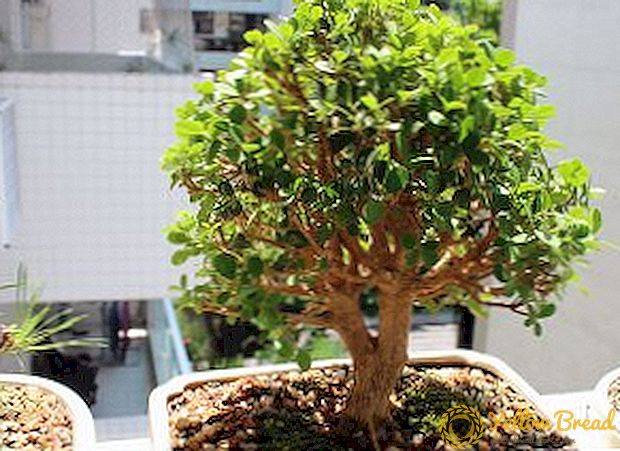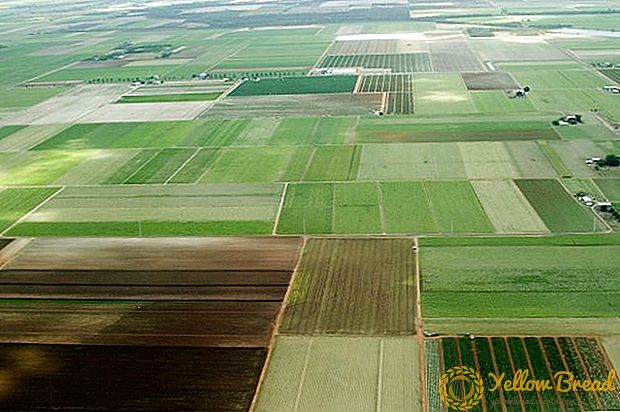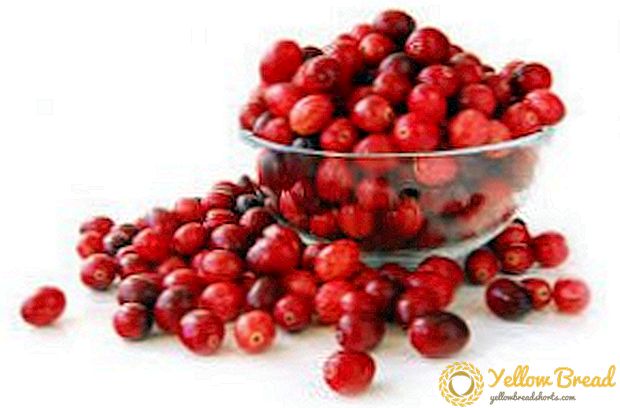 Ranetka - This is the common name for a whole range of hybrid varieties of apple trees, obtained as a result of the selection of popular in Europe apple trees with a frost-resistant variety of apple trees Siberian Berry. The result of crossbreeding was low growth apple trees that are perfectly suitable for a harsh climate and are distinguished by high yields.
Ranetka - This is the common name for a whole range of hybrid varieties of apple trees, obtained as a result of the selection of popular in Europe apple trees with a frost-resistant variety of apple trees Siberian Berry. The result of crossbreeding was low growth apple trees that are perfectly suitable for a harsh climate and are distinguished by high yields.
Unfortunately, the taste and external qualities of these apples do not allow them to be classified as elite varieties; they are small and, as a rule, sour and tart. Of these, you can cook a variety of jams, jams and compotes, but effectively put on the table will not work. But the apple trees of these varieties can survive both winter frosts and unexpected spring frosts, and this is their main advantage. It can be said without exaggeration that Ranetki are apples for Siberia and the Far East.
- Dobrynya
- Long
- Gold
- Red
- Laletino
- Crimson
- Purple
- Siberian
- Torch
- Amber
Dobrynya
This variety, due to its appearance by Krasnoyarsk breeders, is distinguished by high yields (up to 50 kg of fruit can be harvested from one tree during the season) and, like all members of the species, have high winter hardiness. Among other advantages of Dobrynya, it should be mentioned that this apple tree is almost not affected by scab, in addition, it tolerates drought well and grows well.
The first harvest Dobrynya gives at the age of four, ripening occurs in early September. Apples of this variety have a rather long shelf life - subject to the necessary conditions, they can retain their qualities until the end of winter.
The disadvantages of the variety include the fact that the tree demonstrates high yields of the tree: once every three years the apple tree "rests."
Fruit Dobrynya has a slightly oblate shape, ribbed, the skin color is almost one-dimensional purple, the pulp is green, sometimes with red veins. These apples are very juicy and dense, but they have a sour tart taste and very small sizes (their weight is a little more than 10 g), therefore, they are used primarily as a raw material for processing. Mostly from Dobrynia squeeze juice.
Long
Apple Tree For a long time, perhaps, the description is most similar to the fabulous paradise apple trees: a small tree with a broad crown, richly covered over the entire length of numerous branches with white large flowers, and later - with small bright red or red-yellow apples. 
This variety was bred in America in 1917, but the Russian Sibirka was the basis for selection. In Russia, this variety is also called Kitayka, as well as Lilivischy Apple, as its leaves look like plum trees, and small fruits, elongated in the shape of an egg, also resemble plums. The main name of the variety also received a long, "long" shape of the fruit.
Apple tree Long does not grow above five meters in height. The branches of the tree are straight, the tips look up.
FruitAs with other small plants, the weight of apples is usually 11-16 grams (there are, however, apple species for a long time, which have larger fruits). The skin is smooth, red with a blue tint. The flesh of the apple has a cream color, later yellowing, and a dense structure, which eventually becomes soft and crumbly.
The main disadvantage of apples for a long time - very short shelf life. You can eat them only a few weeks after harvesting (in a cold and dark place, the fruit can be preserved for a maximum of two months), so the main purpose of this variety is technical processing.
Apple harvest Long ripens in late summer - early autumn. The first fruiting of a tree begins at the age of three, the yield is abundant, but not regular. During the season, one apple tree produces an average of 175 kg of fruit, but under favorable conditions, this result can be increased by a quarter.
Apple Trees Long due to high frost resistance and unpretentiousness can be grown in regions where gardening is practically not developing. Although this apple tree is not a champion in winter hardiness among the others, it recovers well in the case of frosting.
Gold
Ranetka Golden is one of the most winter-hardy varieties of apple trees, it is also popular due to the very high yield. 
This is a strong and hardy tree, reaching seven meters in height.
The period of fruiting begins with three or four years and is stable. From one tree it is usually possible to collect up to half a centner of small (only 5-7 cm) fruits weighing 10-15 g. Depending on the climate, the crop ripens from July to September. A characteristic feature of this tree is that apples are mostly tied on the upper half of the branches, pulling them to the ground, thanks to which the apple tree takes on a very decorative weeping look.
Apples have golden skin and yellow juicy flesh. The taste is usually sour and tart, but sometimes sweet and sour. Used mainly for processing.
As with the previous variety, Golden Golden Apples apples are very poorly stored, in addition, they have a tendency to crumble badly, and therefore they cannot be delayed with the harvest. Another disadvantage of the variety is its poor resistance to scab.
Red
 Ranetka Krasnaya is another sort of perishable small apples, used primarily for squeezing juices and puriing.
Ranetka Krasnaya is another sort of perishable small apples, used primarily for squeezing juices and puriing.
Harvest this tree starts to bring very early, sometimes the very next year after planting.Regular fruiting is fairly stable. Apples ripen in the last decade of August - early September.
Peel off fruits This tree, as the name implies, is dark red, ribbed, creamy, juicy and starchy. The shape of the apples are almost the right ball. The taste of Reds apples is pretty good, sour, with noticeable tartness.
Particularly high winter hardiness, among others, this variety does not stand out.
Laletino
Laletino - not too common variety of markets. Outwardly, this is a small tree, the crown is round, not too thick. 
The advantage of Laletino apple is the early term of fruiting - at the age of 2-3 years, the tree already produces a crop. However, after each productive year Laletino usually “rests” during the next year. The fruits ripen by early September.
Apples small, flat ribbed shapes. The skin is red, almost monotonous, the flesh is pink in color, dense and juicy, crispy, sweet-sour to the taste.
Crimson
Ranetka Crimson - very winter-hardy representative of the species. 
Differs in early age of the beginning of fructification (approximately the third year after disembarkation), high and stable productivity. Apples ripen in the first half of September.
Fruit this apple tree has small, even for shells, less than 10 g, in shape similar to a plum. The name of the variety is due to the color of the peel of apples, its characteristic feature is also a pronounced bluish bloom. The flesh is juicy, dense, pink in color and sweet-sour taste. Apples do not differ in high flavoring qualities and are used as raw materials for preparation of various preparations.
The advantage of these apples can be called except long shelf life. In a cool place, the Crimson raznetka can lie, without spoiling, until the very spring.
Purple
Among all the fells, it is Purple that is the most winter-hardy variety. It is also less susceptible to spring sunburn and, like other members of the species, has a high yield. 
Fruiting of a tree comes at the age of two or three years.Harvesting occurs at the beginning of September. It is possible to harvest up to one centner of apples from a single tree in a productive year; however, high fructification is not stable, periodicity begins to manifest itself particularly strongly with age.
Purple inset is a fairly powerful tree of medium height. His life span is thirty years or more.
Fruit small (about 9 g), slightly flattened. The skin is red, uniform, the flesh is juicy, medium density, color - cream. Apples have a sour tart taste, characteristic of the markets, allowing them to be used, primarily in a processed form. In addition, the fruits are very poorly stored (maximum - two months).
Siberian
Apple Sibiryachka (the modern name - Beauty of the steppe) is similar to other varieties of ranet in the description.
 Fruiting tree comes from the third or fourth year.The yield is not as high as that of other markets, but the tree is not inferior in winter-hardiness to congeners. Siberian is practically not subject to diseases, in particular, scab.
Fruiting tree comes from the third or fourth year.The yield is not as high as that of other markets, but the tree is not inferior in winter-hardiness to congeners. Siberian is practically not subject to diseases, in particular, scab.
Apples relatively large (sometimes up to 20 g), have the shape of a ball, slightly flattened horizontally, with a small funnel. The peel of the fruit has two colors - yellow main and red cover. Cream-colored flesh, juicy, sweet-sour to taste. With a lack of moisture in the period of ripening of fruits in the taste of apples, a bitter note appears.
Siberian harvest ripens in late summer and can be stored for up to three months, subject to the necessary conditions (dark cool rooms).
Of the others, Siberian women can be distinguished by the high amount of juice contained in its fruits. Like other representatives of the species, these apples are mainly used for processing, in mashed potatoes and juices they are often mixed with carrots and pumpkin.
Torch
This rather popular medium growth variety is the result of the efforts of Krasnoyarsk breeders.
 Tree narrow pyramidal shape, not too thick. Harvest ripens in early September.The period of fructification begins at the age of three years; the yield of a young tree is fairly stable, but with age, strong fluctuations begin. With one tree per season under medium conditions, you can get up to 20 kg of fruit.
Tree narrow pyramidal shape, not too thick. Harvest ripens in early September.The period of fructification begins at the age of three years; the yield of a young tree is fairly stable, but with age, strong fluctuations begin. With one tree per season under medium conditions, you can get up to 20 kg of fruit.
Apples small, on average 15 g, oval (hence the name), smooth with a touch. The peel has a bright crimson color, which becomes more saturated during storage. The flesh is yellowish-pink, with red veins, not very dense, but exceptionally juicy. The taste of apples is sweet and sour, almost no aroma.
The advantage of apples is that they do not have the property to fall from the tree and are transported quite well. However, they can be stored no more than two months.
The apples of Flashlight variety contain a very large amount of ascorbic acid and have excellent qualities in canning, due to which they are widely used in the food industry for preparing juices and mashed potatoes, as well as other preparations. Can be used fresh.
The flashlight is an extremely winter grade of varieties. The tree is able to tolerate lowering temperatures below forty degrees, and even during frosts during the flowering period, almost half of the crop remains.This apple tree also recovers well after freezing and is not affected by scab. However, drought tolerates worse than cold.
Amber
Ranetka Ambernaya due to its origin is also called Altai.
 This is a wide, tall and very dense pyramidal tree shape. Life expectancy is up to 30 years, fruiting begins in the third year and is notable for its abundance and stability.
This is a wide, tall and very dense pyramidal tree shape. Life expectancy is up to 30 years, fruiting begins in the third year and is notable for its abundance and stability.
Apples ripen in the first half of September, harvest time - about a month.
Fruit mass Amber does not exceed 10 g. Apples are ball-shaped, ribbed, skin color is yellow. The flesh is also yellow, dense and juicy.
The taste qualities of apples are not too high, they contain the usual acid and astringency for the screenings. Used mainly as a raw material for the preparation of juices, compotes, jams.
Amber - winter-hardy variety of apple. However, in contrast to other pastures, this variety is unstable to various diseases, mainly apple trees suffer from scab, fruit rot and ermine moths.
 Ranetki - frost-resistant and completely unpretentious apple trees.
Ranetki - frost-resistant and completely unpretentious apple trees.
They can be grown in unsuitable for gardening climatic conditions with cold winters, as well as used as a stock for less hardy apple trees.






